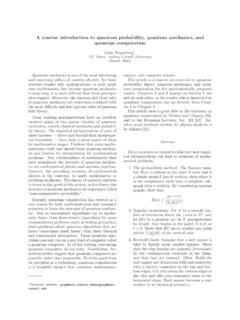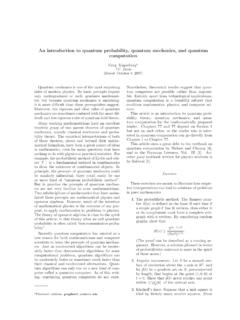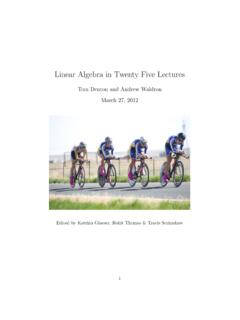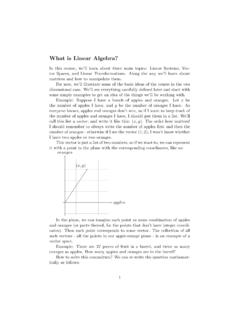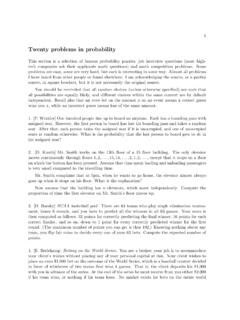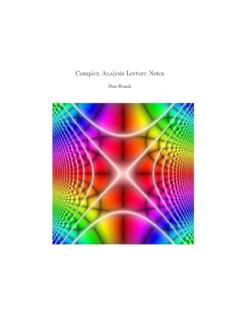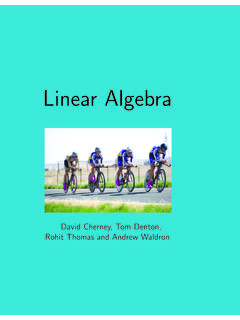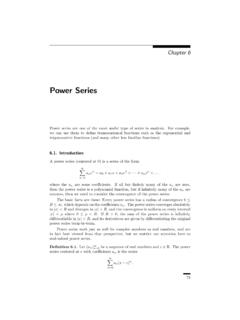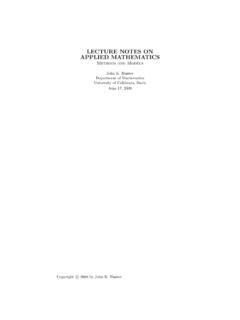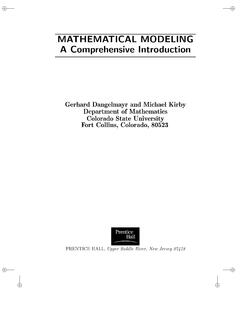Transcription of Some Common Mathematical Symbols and Abbreviations …
1 MAT067 University of California, DavisWinter 2007 Some Common Mathematical Symbolsand Abbreviations (with History)Isaiah Lankham, Bruno Nachtergaele, Anne Schilling(January 21, 2007)Binary Relations= (theequals sign) means is the same as and was first introduced in the 1557 bookTheWhetstone of Witteby Robert Recorde (c. 1510-1558). He wrote, I will sette as I doe oftenin woorke use, a paire of parralles, or Gemowe lines of one lengthe, thus : ==, bicause noe 2,thynges, can be moare equalle. (Recorde used an elongated form of the modern equals sign.)<(theless than sign) mean is strictly less than , and>(thegreater than sign) means is strictly greater than.
2 They first appeared inArtis Analyticae Praxis ad AequationesAlgebraicas Resolvendas( The Analytical Arts Applied to Solving Algebraic Equations ) byThomas Harriot (1560-1621), which was published posthumously in Bouguer (1698-1758) later refined these to ( less than or equals ) and ( greaterthan or equals ) in 1734.:= (theequal by definition sign) means is equal by definition to . This is a Common alternateform of the symbol =Def , which appears in the 1894 bookLogica Matematicaby the logicianCesare Burali-Forti (1861 1931). Other Common alternate forms of the symbol =Def include def= and , the latter being especially Common in applied Symbols from Mathematical Logic (three dots) means therefore and first appeared in print in the 1659 bookTeusche Algebra( Teach Yourself Algebra ) by Johann Rahn (1622-1676).
3 3(thesuch thatsign) means under the condition that . However, it is much more Common (and less ambiguous) to just abbreviate such that as . (theimpliessign) means logically implies that . ( , if it s raining, then it s pouring isequivalent to saying it s raining it s pouring. )The history of this symbol is unclear. (theiffsign) means if and only if and is used to connect logically equivalent statements.( , it s raining iff it s really humid means simultaneously that if it s raining, then it sCopyrightc 2007 by the authors. These lecture notes may be reproduced in their entirety for humid and that if it s really humid, then it s raining.)
4 In other words, the statement it s raining implies the statement it s really humid and vice versa.)This notation iff is attributed to the great mathematician Paul R. Halmos (1916 2006). (theuniversal quantifiersymbol) means for all and was first used in the 1935 publicationUntersuchungen ueber das logische Schliessen( Investigations on Logical Reasoning ) byGerhard Gentzen (1909-1945). He called it theAll-Zeichen( all character ), in analogy with (read: there exists ). (theexistential quantifier) means there exists and was first used in the 1897 bookFor-mulaire de mathematiqusby Giuseppe Peano (1858-1932).
5 (theHalmos tombstone) means QED , which is an abbreviation for the Latin phrasequoderat demonstrandum( which was to be proven ). QED has been the most Common wayto symbolize the end of a logical argument for many centuries, but the modern convention inmathematics is to use the tombstone in place of QED .This tombstone notation is attributed to the great mathematician Paul R. Halmos (1916 2006).Some Notation from Set Theory (theis included insign) means this set is a subset of and (theincludessign) means this set has as a subset . They were introduced in the 1890 bookVorlesungen uber dieAlgebra der Logik( Lectures on the Algebra of the Logic ) by Ernst Schr oder (1841-1902).
6 (theis insign) means is an element of and first appeared in the 1895 bookFormulairede mathematiqusby Giuseppe Peano (1858-1932). Peano originally used the Greek letter (which is the first letter of the Latin wordest, meaning is ), but it was Betrand Russell (1872-1970) in his 1903 Principles of Mathematicsthat introduced the modern stylized version. (theunionsign) means take the elements that are in either set , and (theintersectionsign) means take the elements that the two sets have in Common . They were introducedin the 1888 bookCalcolo geometrico secondo l Ausdehnungslehre di H. Grassmann precedutodalle operazioni della logica deduttiva( Geometric Calculus based upon the teachings of , preceded by the operations of deductive logic ) by Giuseppe Peano (1858-1932).
7 (thenull setorempty setsymbol) means the set without any elements in it and wasfirst used in the 1939 book El ements de math ematiqueby N. Bourbaki (a group of primarilyEuropean mathematicians not a single person). It was borrowed simultaneously from theNorwegian, Danish and Faroese alphabets by group member Andr e Weil (1906-1998). (infinity) denotes a number of arbitrarily large magnitude and first appeared in print inthe 1655 bookDe Sectionibus Conicus( On Conic Section ) by John Wallis (1616-1703).Conjectured explanations for why Wallis used this symbol include its resemblance to thesymbolooused by Romans to denote the number 1000, its resemblance to the final letterof the Greek alphabet (and so is synonymous with being the final number), and thesymbolism of the fact that one can traverse a given curve infinitely Important Numbers in Mathematics (theratio of the circumference to the diameter of a circle) denotes the.
8 , and was first used by William Jones (1675-1749) in his 1706 bookSyn-opsis palmariorum mathesios( A New Introduction to the Mathematics ). However, it wasLeonhard Euler (1707-1783) who first popularized the use of the letter for this number inhis 1748 bookIntroductio in Analysin people speculate that Jones chose the letter because it s the first letter in Greek wordperimetron( o ), which roughly means around .e= limn (1 +1n)n(thenatural logarithm base) denotes the number ..,and was first used by Leonhard Euler (1707-1783) in the manuscriptMeditatio in Experimentaexplosione tormentorum nuper instituta( Meditation on experiments made recently on thefiring of cannon ), written when he was just 21 years old.
9 (Note thateis the first letter inexponential.)The very famous mathematician Edmund Landau (1877-1938) once wrote that The letteremay now no longer be used to denote anything other than this positive universal constant. = limn ( nk=11k lnn) (theEuler-Mascheroni constant) denotes the number ..,and was first used by Lorenzo Mascheroni (1750-1800) in his 1792 Adnotationes ad Euleri Cal-culum Integralem( Annotations to Euler s Integral Calculus ).The number is usually considered to be the third most important important non-basicnumber in mathematics, following closely 1 (theimaginary unit) was first used by Leonhard Euler (1707-1783) in his 1777memoirInstitutionum calculi integralis( Foundations of Integral Calculus ).
10 Appendix: Some Common Latin Abbreviations and Phrases(Cf. ) (id est) means that is or in other words . (It is used to paraphrase a statement that wasjust made,notto mean for example , and isalwaysfollowed by a comma.) (exempli gratia) means for example . (It is usually used to give an example of a statementthat was just made and isalwaysfollowed by a comma.)viz.(videlicet) means namely or more specifically . (It is used to clarify a statement that wasjust made by providing more information and isneverfollowed by a comma.)etc.(et cetera) means and so forth or and so on . (It is used to suggest that the reader shouldinfer further examples from a list has been started and isusually notfollowed by a comma.)
